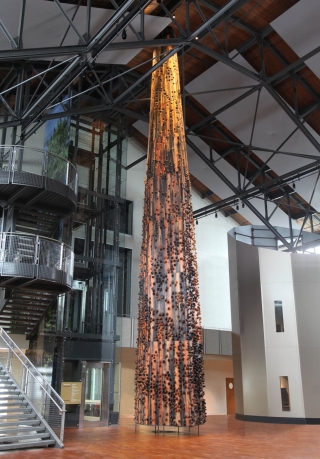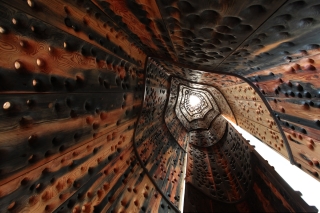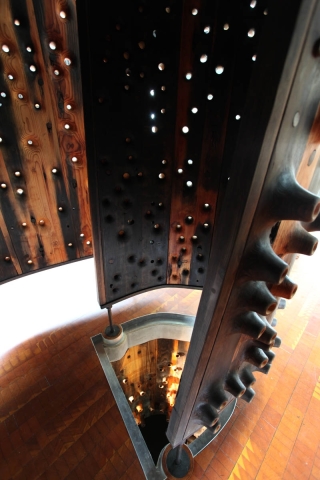|
Subscribe / Renew |
|
|
Contact Us |
|
| ► Subscribe to our Free Weekly Newsletter | |
| home | Welcome, sign in or click here to subscribe. | login |
Construction
| |

February 14, 2013
MOHAI’s ‘Wawona': 11,000 pounds of wood and steel moves with a gentle push
Journal Staff Reporter
Artist John Grade needn't worry whether visitors to the Museum of History & Industry will take notice of his handiwork.
His new sculpture “Wawona” stretches 56 feet from top to bottom in the museum's grand atrium, attracting curious museumgoers with its looming presence. It looks at first like a wayward tree punching up through the building, but its size belies a weightlessness that becomes more evident up close.
That's thanks to a hidden structural system that allows the 11,000-pound sculpture to hang from the ceiling and even sway if given a push or shake. The base is about a foot off the floor, where it's held in place by a set of thin restraining rods bolted to the floor.
A pair of openings at the base of the sculpture allows visitors room to step inside the hollow core for a tunnel-like view of the interior, which tapers above. On the roof is a 2.5-foot-long extension of the sculpture, where it's being left to artfully deteriorate amid the elements.
Beneath the sculpture, a piece of the floor was knocked out and replaced with a thick Plexiglas window through which visitors can peer into Lake Union. A 5-foot-long extension of the sculpture, following the exact same shape as above, reaches from the underside of the museum pier into the water.
The artwork required about two years to plan and complete, Grade said.
The sculpture takes its name from the Wawona, a schooner built in 1897 and retired in 1947 after serving as a lumber and fishing vessel and later as a World War II military barge. It deteriorated over the ensuing decades, however, and its owner, Northwest Seaport, ruled out a costly rehabilitation and instead donated part of the vessel for use in the project.
The Wawona was towed from its longtime home next to the current MOHAI building on Lake Union and disassembled at a nearby dry dock.
Steel collars
One of the challenges of the disassembly process was pulling apart the vessel without ruining the wood, much of which was held together with wrought iron pins. The wood had to be chiseled apart carefully, Grade said.
The process yielded 20 to 30 giant slabs of Douglas fir up to 120 feet long from the hull. The planks were 18 inches wide and 4 inches thick.
The wood displayed rich coloration after years of deterioration and staining from the wrought iron pins. That deterioration left the wood soft in places, making it structurally unreliable.
“Aesthetically, it was this Christmas gift,” Grade said, and its condition helped dictate the eventual form of the sculpture.
Grade enlisted Hans-Erik Blomgren, a structural engineer at Arup, to design the steel bones that would support the artwork.
Arup has built up a niche designing structural systems for artistic installations. The work gives engineers a chance to tinker and break new ground, Blomgren said.
The system he devised for the sculpture involved nine sets of steel collars that bolt together, each adding another vertical tier ranging from about 3.5 to 9 feet long. Carefully cut wood planks — about 200 in all — each slide snugly into the collars, obscuring them from view. Steel ribs run between the top and bottom of the collars and nestle vertically between the planks to help hold them in place. Small gaps between the planks allow room for the wood to expand and contract.
No two planks are shaped exactly alike. The design process was helped along by digital modeling that allowed Grade to make changes on the fly.
Jeff Hudak and Amanda Bruot of Studio Fifty50 performed the modeling and fabrication.
The planks were shaped using a CNC router at a wood fabrication shop at the University of Washington, where Hudak also teaches in the College of Built Environments. Each plank was machined to within less than 1/32 of an inch of specifications on five of its six sides.
The fabrication process took 1,500 hours over four months, Hudak said. In some cases the planks had to be sliced apart and glued back together to form the “twisted geometries” required by the design.
Once the cutting was finished, all the pieces fit together properly and needed no further adjustments, Hudak said.
“It was like a big erector set,” Hudak said of the components.
The steel collars and hanger rods were fabricated with a water-jet cutter by Pegasus Northwest.
Rubber rings
Blomgren's steel structural design had to take into account stresses from earthquakes, jostling from visitors and an assumed 50-year lifespan. To help calculate horizontal loads, he said he held a bathroom scale against the wall to see how hard he could reasonably push.
“It's scary to feel 11,000 pounds move with very little effort,” Blomgren said. “We wanted to have something that gave perceptible movement” without alarming city inspectors.
The team, with input from the city, settled on 4 inches of horizontal movement, using a special type of rubber dampening ring that allows the sculpture to swing from its attachment point on the roof without springing back into place too rudely. Additional dampening rings around restraining rods on the floor provide more support.
Blomgren worked with Coughlin Porter Lundeen, the structural engineer for the MOHAI building renovation, to add reinforcements to the roof structure and underneath the building.
Before assembling the sculpture, the exterior wood surfaces received additional shaping to add textures such as knot-sized holes and pimply protuberances that Grade referred to as “flutes.” The shapes add movement to the sculpture, he said, and are inspired by wave forms as well as calcium shells left behind by phytoplankton.
Final assembly took place inside the museum over a three-and-a-half-day span. Crews used scaffolding as they bolted the sculpture together tier by tier.
The rigging and installation was completed by Artech.
Grade said it's been “very, very satisfying” to see visitors enjoying the sculpture — inspecting the flutes, giving it a gentle shove, and lining up to look inside.
Museumgoers don't expect to see art at a place like MOHAI, he said, and people may be able to relate to the sculpture differently there than they would at an art museum, where “do not touch” is the rule.
But “Wawona” is intended to work as history, too. The schooner from which the piece takes its name was the first vessel to be placed on the National Register of Historic Places, according to HistoryLink.org. And the outdoor components of the sculpture will weather over time, reminding us that sooner or later everything becomes history.
Jon Silver can be
reached by email or by phone
at (206) 622-8272.
Previous columns:
- The dirt on Washington's new dig law, 02-07-2013
- Steel fiber concrete cuts need for rebar, 01-31-2013
- Turner's CM school gives struggling subs a spark, 01-24-2013
- 366 acres of streets and alleys in Seattle will turn green to help treat stormwater, 01-17-2013
- Unclouding the haze of construction liens, 01-10-2013
- Women are 'excellent candidates' for construction, 01-03-2013
- How to keep thieves off your jobsite, 12-20-2012
- WSDOT builds snowplows in its 'Monster Garage', 12-13-2012





